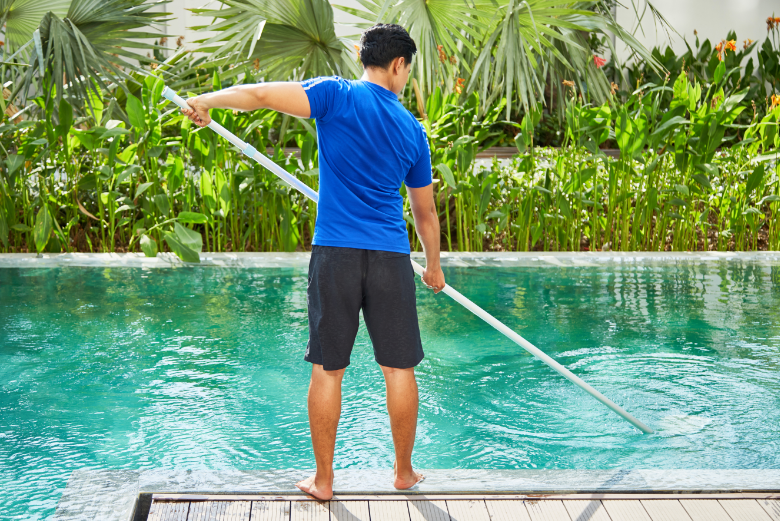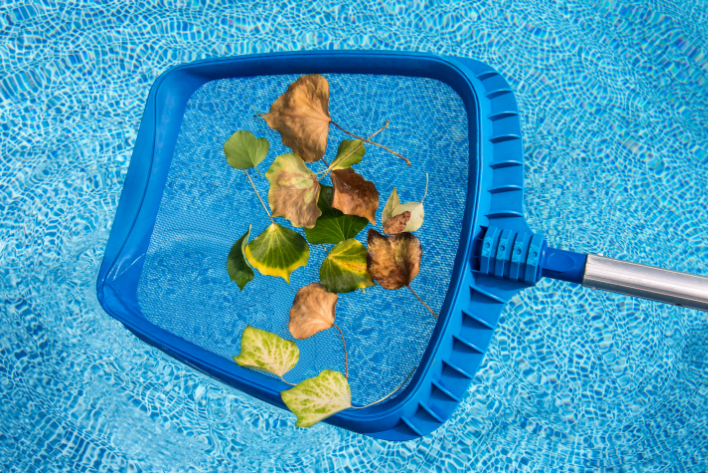POOL GUIDES
Helpful Tips For Pool Owners

Spring/Summer Pool & Spa Care
-
Increase pool filter running hours from 4 to 8 hours a day
-
Check your filter and change the running mode from winter to summer.
-
Regularly check sanitiser levels, ideally on a daily basis.
-
Check the pH every two days, and maintain between 7.2 and 7.8. Use pH increaser or pH decreaser to adjust pH if necessary.
-
Add sunscreen to reduce the loss of chlorine by sunlight.
-
Check Total Alkalinity weekly.
-
Regularly check and clean the skimmer basket and hair and lint pot basket.
-
Thoroughly clean the pool and vacuum the walls and floor.
-
Check or replace fittings and check for leaks.
-
Prevent algae growth during the peak swimming season with a preventative algaecide or/and algae starver.
-
Check the pump is working properly and organise a full pool equipment service by a professional pool and spa technician if necessary.

Autumn/Winter Pool & Spa Care
- Decrease pool filter running hours from 8 to 3-4 hours a day.
- Check your filter and change the running mode from summer to winter.
- Regularly check sanitiser levels, ideally on a weekly basis.
- Check the pH every fortnight, and maintain between 7.2 and 7.8. Use pH increaser or pH decreaser to adjust pH if necessary.
- Check Total Alkalinity fortnightly.
- Thoroughly clean the pool and vacuum the walls and floor every few weeks.
- Regularly check pool equipment is working properly.
- Use a shock treatment throughout winter. Once appropriate levels have been added, run both the pump and filter for several hours to ensure it has been well distributed.
- Use an algaecide that’s appropriate for your pool.
- Use a pool cover when the pool is not in use to prevent water loss and stop debris from contaminating water.
POOL CLEANING
Have you ever wondered which type of pool cleaner is for you? Keeping your pool clean may seem like a daunting and time-consuming task, but the wide variety of cleaning equipment available today means you can have a sparkling clean pool with minimal effort.
We offer an extensive range of pool cleaning systems to suit your swimming pool, your lifestyle and your budget. Here is a basic explanation of different pool cleaners to help you understand which would be the right choice for you, your pool and your budget.
Manual Vacuum
Most pool owners receive one of these with their new pool. It consists of a vacuum head attached to a telepole with a house that connects to the special fitting in the skimmer box. A manual vacuum cleaner means you do the work. 45 minutes to an hour each time picking up leaves, dirt and debris. Effective but time consuming.
Pressure Cleaners
Pressure cleaners use an individual boost pump to pressurise filtered water from the pool return line and blast the swimming pool surface. Because pressure pool cleaners place the debris in their own collection containers, they help to take the pressure off the swimming pool’s filtration system.
Electric Self-propelled Cleaners
Pressure cleaners use an individual boost pump to pressurise filtered water from the pool return line and blast the swimming pool surface. Because pressure pool cleaners place the debris in their own collection containers, they help to take the pressure off the swimming pool’s filtration system.
Suction Cleaners
These cleaners rely on suction to get them moving and to allow them to vacuum the debris from the pool floor. The units are generally cheaper to install than some other cleaners and operate when the filtration system is operating. The downside of suction cleaner is that the skimmer is not doing the job it is supposed to do which is to skim the top of the water and remove debris before it drops to the floor. Water flow is obviously greater through the filtration system when nothing is connected to the skimmer and water clarity can be reduced using an automatic cleaner.
If you are in an area with a lot of trees and leaves, this may not be the best option for you and all the debris gets sucked straight into your skimmer basket and can cause a reduction in water flow potentially causing damage to the pump. If you are in a leaf free zone then this could be the right choice for your pool.
The only other thing to remember with suction cleaner is to make sure your filter is clean. A dirty filter reduces water flow and therefore, suction, which affects the ability of the pool cleaner to move.
Robotic Pool Cleaners
These are driven by electric motors inside the unit. The electricity that powers the cleaner comes from a transformer that you plug into an outdoor outlet. The transformer converts the outlet electricity to a low voltage which is then connected to the cleaner via a long cord.
A robot cleaner vacuums debris directly into its own filter and is the best option when it comes to small and large debris. The inbuilt “brain” helps the cleaner to learn the shape and size of the pool ensuring it manoeuvres around the pool to check if there is any spot it may have missed.
Robot cleaners also act as a great way to circulate the water in your pool – not only by the amount of water passing through them resulting in fine debris being collected but also because they are not connected through the skimmer box which allows the pools skimming action to take place. Robot cleaners will also scrub the walls and tile line (depending on which model you choose) reducing the need for manual cleaning.
In-floor Pool Cleaning System
In-floor cleaning systems are in-built systems that are installed together with your swimming pool, requiring virtually no maintenance after installation. These types of cleaners use an individual pump and a distribution system that directs debris to several collection points, which are the cleaned out by the pool filter.
Building A Pool
Where to begin?
Building a swimming pool makes a huge difference to your house and your lifestyle. But it is undeniably a large process that may have you wondering where to begin. There are a huge range of options, sizes, shapes and finishes for the pool, and that’s without even considering the builder or the mechanics of the pool system. Thankfully, our pool years of building pools we have tried making it wasy for you and have made this series of guides to help you get started.
If you are lucky enough to have an architect designing your home and swimming pool, discuss your wish list with him. Or otherwise if you are making the decisions yourself, you can just give us a call discuss the various pool options.
The design and build of your swimming pool is a decision that will reflect numerous factors, including importantly your personal taste. This early research will help you to narrow your choices to a manageable number where you can start to take the right step going forward. As your pool builder we will generally provide help in all the planning and council approvals stages.
Where to build?
When determining where you want to build your new pool, there are some things to take into account. A swimming pool can transform your backyard and your lifestyle. And with a bit of careful planning, you’ll be able to create a functional, visually appealing space that makes the most of your outdoor living area.
Location & Orientation
How will the sun, shade and wind affect your swimming pool? To help heat retention, choose a spot that gets plenty of sun, isn’t obstructed by buildings or large trees, and has some wind protection. Nearby trees and other plants can be a source of leaves and insects, so it’s best to install your pool away from vegetation.
Accessibility for construction equipment is probably paramount to consider. The perfect location is only perfect if you are not carrying the soil out by hand. Soil type will also play a part as will your gardens dimensions and whether the block is sloping or not.
Council Approval
Any swimming pool that contains more than 300mm of water and uses a water filter needs to have council approval before it can be installed. Once you’ve decided on the pool design and location, you’ll need to submit plans and specifications to your local council. We are able to help you with your application.
Safety
Across Australia, pool safety regulations require that every swimming pool is surrounded by a childproof safety fence. You can choose from several types of fences, but you need to make sure that it meets relevant Australian Standard safety requirements. It’s also a good idea to choose a pool location that’s easy to supervise.
Aesthetic Features
Whether you choose to make your pool the focal point of your backyard or create a harmonious outdoor environment, you should consider the aesthetic aspects of your overall design. The house architecture, garden design, lighting, water features and waterfalls will all impact your choice of pool design.
Pool Size & Style
The type of pool you select will depend on a number of factors, including the size and layout of your backyard, how many people will use it, how, and how often you plan to use it. If you intend to do laps, you’ll generally need a longer and deeper pool. The size of pool you require will also assist you in establishing the perfect location for your pool and whether or not your wish to keep lawn and gardens around the area or create a patio lifestyle with the pool as the focus.

CALL NOW FOR A QUOTE:
0423 251 732
How A Swimming Pool Works
A pool owner who has a basic understanding of how their pool works becomes instantly better at solving pool issues and maintaining their pool. Thankfully it’s easy to understand when you can look at a diagram and see how the components of your pool work together.
Pool water moves in a continuous cycle driven by the pump. Equipped with an electric motor, the pump has an impeller that drives water through the skimmers (found at the top of a pool) and the sumps (found at the bottom of a pool) take it to the filter. The clean, filtered water is then piped through the return nozzles (a series of small valves placed around the pool).

